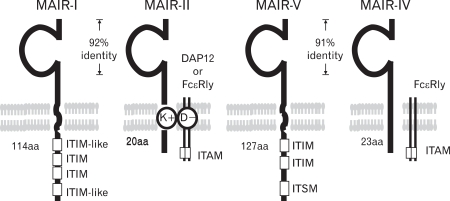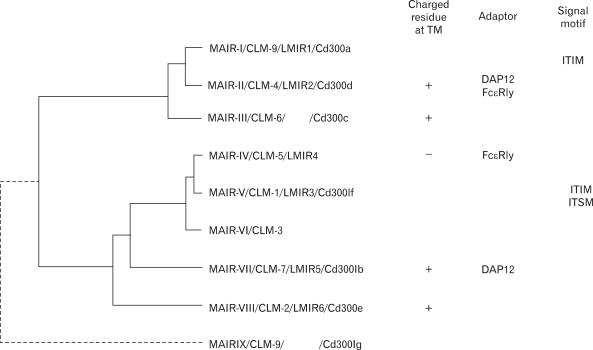Immune Netw.
2009 Apr;9(2):41-45. 10.4110/in.2009.9.2.41.
Regulation of Immune Responses by the Activating and Inhibitory Myeloid-Associate Immunoglobuline-Like Receptors (MAIR) (CD300)
- Affiliations
-
- 1Department of Immunology, Institute of Basic Medical Sciences, Graduate School of Comprehensive Human Sciences, University of Tsukuba, Ibaraki, Japan. ashibuya@md.tsukuba.ac.jp
- KMID: 1474593
- DOI: http://doi.org/10.4110/in.2009.9.2.41
Abstract
- Activating and inhibitory cell surface receptors play important roles in regulation of immune responses. Recent progress has demonstrated that many inhibitory receptors pair with activating, as well as inhibitory, isoforms, both of whose genes are located in small clusters on a chromosome. We and others identified paired activating and inhibitory immunoglobulin-like receptors, designated myeloid-associated immunoglobulin-like receptors (MAIR) (CD300). MAIR is a multigene family consisting of nine genes on a small segment of mouse chromosome 11. MAIR family receptors are preferentially expressed on myeloid cells, including macrophages, dendritic cells, granulocytes, and bone-marrow-derived cultured mast cells, and a subset of B cells and regulate activation of these cells. Thus, MAIR plays an important role in innate immunity mediated by myeloid cells.
Keyword
MeSH Terms
Figure
Reference
-
1. Ravetch JV, Lanier LL. Immune inhibitory receptors. Science. 2000; 290:84–89. PMID: 11021804.
Article2. Lanier LL. Face off--the interplay between activating and inhibitory immune receptors. Curr Opin Immunol. 2001; 13:326–331. PMID: 11406364.3. Malbec O, Fong DC, Turner M, Tybulewicz VL, Cambier JC, Fridman WH, Daëron M. Fc epsilon receptor I-associated lyn-dependent phosphorylation of Fc gamma receptor IIB during negative regulation of mast cell activation. J Immunol. 1998; 160:1647–1658. PMID: 9469421.4. Smith KM, Wu J, Bakker AB, Phillips JH, Lanier LL. Ly-49D and Ly-49H associate with mouse DAP12 and form activating receptors. J Immunol. 1998; 161:7–10. PMID: 9647200.5. Lanier LL, Bakker AB. The ITAM-bearing transmembrane adaptor DAP12 in lymphoid and myeloid cell function. Immunol Today. 2000; 21:611–614. PMID: 11114420.
Article6. Love PE, Shores EW. ITAM multiplicity and thymocyte selection: how low can you go? Immunity. 2000; 12:591–597. PMID: 10894159.7. Takai T, Ono M. Activating and inhibitory nature of the murine paired immunoglobulin-like receptor family. Immunol Rev. 2001; 181:215–222. PMID: 11513143.
Article8. Martin AM, Kulski JK, Witt C, Pontarotti P, Christiansen FT. Leukocyte Ig-like receptor complex (LRC) in mice and men. Trends Immunol. 2002; 23:81–88. PMID: 11929131.
Article9. Nathan C. Neutrophils and immunity: challenges and opportunities. Nat Rev Immunol. 2006; 6:173–182. PMID: 16498448.
Article10. Kumagai H, Oki T, Tamitsu K, Feng SZ, Ono M, Nakajima H, Bao YC, Kawakami Y, Nagayoshi K, Copeland NG, Gilbert DJ, Jenkins NA, Kawakami T, Kitamura T. Identification and characterization of a new pair of immunoglobulin-like receptors LMIR1 and 2 derived from murine bone marrow-derived mast cells. Biochem Biophys Res Commun. 2003; 307:719–729. PMID: 12893283.
Article11. Chung DH, Humphrey MB, Nakamura MC, Ginzinger DG, Seaman WE, Daws MR. CMRF-35-like molecule-1, a novel mouse myeloid receptor, can inhibit osteoclast formation. J Immunol. 2003; 171:6541–6548. PMID: 14662855.
Article12. Luo K, Zhang W, Sui L, Li N, Zhang M, Ma X, Zhang L, Cao X. DIgR1, a novel membrane receptor of the immunoglobulin gene superfamily, is preferentially expressed by antigen-presenting cells. Biochem Biophys Res Commun. 2001; 287:35–41. PMID: 11549249.
Article13. Nakano T, Tahara-Hanaoka S, Nakahashi C, Can I, Totsuka N, Honda S, Shibuya K, Shibuya A. Activation of neutrophils by a novel triggering immunoglobulin-like receptor MAIR-IV. Mol Immunol. 2008; 45:289–294. PMID: 17543387.
Article14. Fujimoto M, Takatsu H, Ohno H. CMRF-35-like molecule-5 constitutes novel paired receptors, with CMRF-35-like molecule-1, to transduce activation signal upon association with FcRgamma. Int Immunol. 2006; 18:1499–1508. PMID: 16940041.15. Shi L, Luo K, Xia D, Chen T, Chen G, Jiang Y, Li N, Cao X. DIgR2, dendritic cell-derived immunoglobulin receptor 2, is one representative of a family of IgSF inhibitory receptors and mediates negative regulation of dendritic cell-initiated antigen-specific T-cell responses. Blood. 2006; 108:2678–2686. PMID: 16794255.
Article16. Cantoni C, Bottino C, Augugliaro R, Morelli L, Marcenaro E, Castriconi R, Vitale M, Pende D, Sivori S, Millo R, Biassoni R, Moretta L, Moretta A. Molecular and functional characterization of IRp60, a member of the immunoglobulin superfamily that functions as an inhibitory receptor in human NK cells. Eur J Immunol. 1999; 29:3148–3159. PMID: 10540326.
Article17. Clark GJ, Green BJ, Hart DN. The CMRF-35H gene structure predicts for an independently expressed member of an ITIM/ITAM pair of molecules localized to human chromosome 17. Tissue Antigens. 2000; 55:101–109. PMID: 10746781.
Article18. Clark GJ, Cooper B, Fitzpatrick S, Green BJ, Hart DN. The gene encoding the immunoregulatory signaling molecule CMRF-35A localized to human chromosome 17 in close proximity to other members of the CMRF-35 family. Tissue Antigens. 2001; 57:415–423. PMID: 11556966.
Article19. Yotsumoto K, Okoshi Y, Shibuya K, Yamazaki S, Taharaanaoka S, Honda S, Osawa M, Kuroiwa A, Matsuda Y, Tenen DG, Iwama A, Nakauchi H, Shibuya A. Paired activating and inhibitory immunoglobulin-like receptors, MAIR-I and MAIR-II, regulate mast cell and macrophage activation. J Exp Med. 2003; 198:223–233. PMID: 12874256.
Article20. Nakahashi C, Tahara-Hanaoka S, Totsuka N, Okoshi Y, Takai T, Ohkohchi N, Honda S, Shibuya K, Shibuya A. Dual assemblies of an activating immune receptor, MAIR-II, with ITAM-bearing adapters DAP12 and FcRgamma chain on peritoneal macrophages. J Immunol. 2007; 178:765–770. PMID: 17202337.21. Okoshi Y, Tahara-Hanaoka S, Nakahashi C, Honda S, Miyamoto A, Kojima H, Nagasawa T, Shibuya K, Shibuya A. Requirement of the tyrosines at residues 258 and 270 of MAIR-I in inhibitory effect on degranulation from basophilic leukemia RBL-2H3. Int Immunol. 2005; 17:65–72. PMID: 15569773.
Article22. Takaki R, Watson SR, Lanier LL. DAP12: an adapter protein with dual functionality. Immunol Rev. 2006; 214:118–129. PMID: 17100880.
Article23. Kim MK, Huang ZY, Hwang PH, Jones BA, Sato N, Hunter S, Kim-Han TH, Worth RG, Indik ZK, Schreiber AD. Fcgamma receptor transmembrane domains: role in cell surface expression, gamma chain interaction, and phagocytosis. Blood. 2003; 101:4479–4484. PMID: 12756162.
- Full Text Links
- Actions
-
Cited
- CITED
-
- Close
- Share
- Similar articles
-
- Co-Stimulatory Receptors in Cancers and Their Implications for Cancer Immunotherapy
- Autophagy as an Innate Immune Modulator
- Human CD8+ T-Cell Populations That Express Natural Killer Receptors
- Fcgamma Receptors Modulate Pulmonary Inflammation by Activating Innate Immune Cells in Murine Hypersensitivity Pneumonitis
- Human diversity of killer cell immunoglobulin-like receptors and disease




